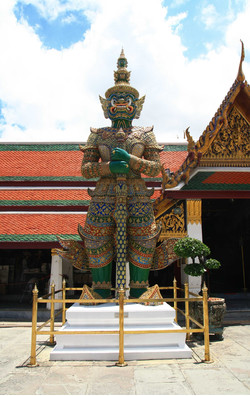Artwork Search
Arts in Southeast Asia Database
Yakṣas at the Temple of the Emerald Buddha
Keywords :
| Artwork alternative name | Dvarapala yakṣas |
|---|---|
| Site common name | Wat Phra Si Rattana Satsadaram |
| Site alternative name | Temple of the Emerald Buddha |
| Type of artwork | Sculpture |
| Sub district | Phra Borom Maha Ratchawang |
| District | Khet Phra Nakhon |
| Province | Bangkok |
| Region | Central |
| Country | Thailand |
| Geographic Coordinates DMS | Lat : 13.75121 Long : 100.493048 |
| Geographic Coordinates UTM | Zone : 47 P Hemisphere : N E : 661422.05 N : 1520713.21 |
| Place of artwork | Next to the inner side of the galleries’ entrances |
| History of production | The exact date of construction is unknown. 8 of the Yakṣa sculptures might presumably be created in the reign of King Rama III and the rest were built in the reign of King Rama V. Prince Narisaranuvadtivongs hypothesized that “…The Yakṣas at the Temple of the Emerald Buddha might be initially built in the reign of King Rama III, as I can remember that Thotsakan and Sahatsadecha sculptures were the works of Luang Theprotchana (Kan) who was also the sculptor who created the Yakṣas at Wat Arun. It can be conjectured that there were some great sculptors and artists at that time; so the Yakṣas were built. Inner cores of these sculptures were wood, so they became decayed later on. A hundred years later, these sculptures were restored. I reckon it’s reasonable to do so, as there were some skillful sculptors and artists back then...” |
|---|---|
| Production process | Stucco decorated with glazed porcelain tiles |
| Conservation | The building of these Yakṣas is mentioned in a book titled ‘Archives Regarding the Restoration of Wat Phra Si Rattana Satsadaram and the Grand Palace on the Occasion of the Bicentennial Celebration of Rattanakosin in 1982: Part I Wat Phra Si Rattana Satsadaram’ as follows: “…during the restoration of Wat Phra Si Rattana Satsadaram in order to prepare the celebrations of Bangkok’s 100th anniversary and the Emerald Buddha in 1882, King Rama V requested the royal family members to join in the restoration and commissioned Prince Narisaranuvadtivongs as the head to restore Ho Phrakhanthararat and Phra Mondop Yod Prang including laying new stone tiles, repairing the boundary wall, restoring the ceilings, paintings, stucco, and exterior niches, and creating a pair of Yakṣa stucco sculptures adorned with glazed porcelain. Moreover, all of the Dvarapala Yakṣas were fully restored during the bicentenary celebration of Rattanakosin in 1982. |
| Size | Approximate 6 m. |
| Art | The 12 sculptures are made of stucco with colorful glazed porcelain adornments according to Rammakian including different types of crowns, blouses, costumes, pointed sandals, etc. Their bodies were also painted according to the literary work. 6 pairs of Yakṣas are as follows: 1.Suriyaphop – Intharachit 2.Mangkonkan – Wirunhok 3.Thotsakhichanthon – Thotsakhiriwan 4.Chakrawat – Atsakanmarasun 5.Thotsakan - Sahatsadecha Maiyarap - Wirunchambang |
| Key academic information | Gigantic sculptures of Yakṣas standing in pairs around the ordination hall or Ubosot of Wat Phra Si Rattana Satsadaram; and 6 pairs of them stand at each side of the gallery entrance with a club in their hands, facing towards the Ubosot. These Yakṣas are characters in Ramayana or Rammakian in Thai which was composed in Thai version by King Rama I. The chief Yakṣas are such as Ravana or Thotsakan (the green Yakṣa) and Sahatsadecha (the white Yakṣa). The 12 Yakṣas serve as Dvarapala or the guardian of the gates at Wat Phra Si Rattana Satsadaram, and displaying Yakṣa sculptures at the royal temple may refer to a mark of honor to the kings often refered to as Rama of an avatar of Viṣṇu who was victorious over the Yakṣas. Sculptures of Dvarapala Yakṣas can also be found in several importan royal temples in early Rattanakosin period; for instance, Wat Arunratchawaram (Wat Chaeng) and Wat Phrachetuphon Wimonmangkhararam (Wat Pho). This shows that Rammakian is not only a precious royal literary work, but it also affects artistic works in early Rattanakosin period. Although Rammakian is derived from Brahmanism’s beliefs, it’s interested in using the Yakṣas, the antagonists, as Dvarapalas who protect Buddhist monasteries. This may imply some morals, namely good always wins over evil. |
| Art period | Rattanakosin |
| Age | 25th Buddhist century |
| Religion and belief | Traditions in the Thai Royal Court, Brahmanism |
| Legend | Ramayana |
| Related artwork | Yakṣas at Wat Arunratchawararam or Wat Chaeng, Yakṣas at Wat Phrachetuphon Wimonmangkhararam or Wat Pho |
| Type of License | Attribution-NonCommercial-NoDerivs (CC BY-NC-ND) |
|---|---|
| Rights | Princess Maha Chakri Sirindhorn Anthropology Centre |
| Date of record creation | 2016-06-15 |
| Record creator | Patsaweesiri Premkulanan |
| Bibliography | นริศรานุวัดติวงศ์, สมเด็จเจ้าฟ้ากรมพระยา. สาส์นสมเด็จ. เล่มที่ 26. พระนคร: องค์การค้าของคุรุสภา, 2505. จดหมายเหตุเรื่องปฏิสังขรณ์วัดพระศรีรัตนศาสดาราม ครั้งรัชกาลที่ 3.พระนคร : โรงพิมพ์โสภณพิพรรฒธนากร, 2465. กรมศิลปากร. จดหมายเหตุการบูรณะปฏิสังขรณ์วัดพระศรีรัตนศาสดารามและพระบรมมหาราชวัง ในการฉลองพระนครครบ 200 ปี พุทธศักราช 2525 : ภาคที่ 1 วัดพระศรีรัตนศาสดาราม. กรุงเทพฯ : กรมศิลปากร, 2525. สุภัทรดิศ ดิศกุล, หม่อมเจ้า. ประวัติวัดพระศรีรัตนศาสดาราม. กรุงเทพฯ : สำนักพระราชวัง, 2534. |


